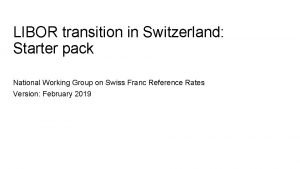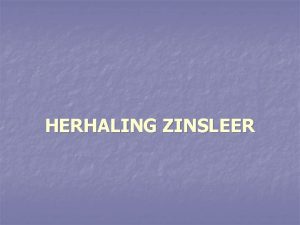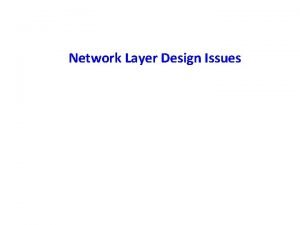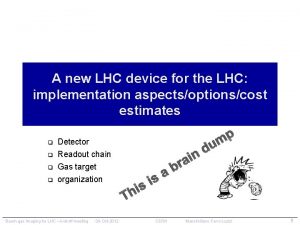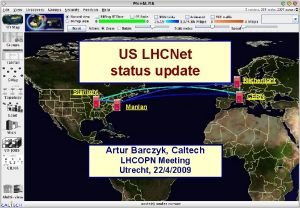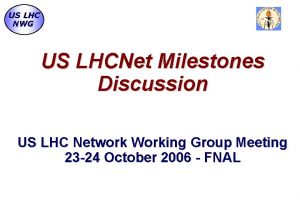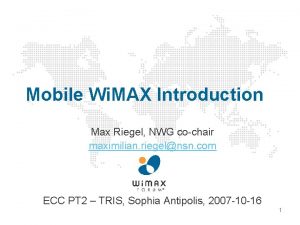US LHC NWG US LHC Network WG Issues






- Slides: 6

US LHC NWG US LHC Network WG Issues US LHC Network Working Group Meeting 23 -24 October 2006 - FNAL

US LHC NWG US LHC Network Working Group Production Network Issues (1/2) u Implementing, maintaining and evolving the Roadmap è Bandwidth and cost evolution è Funding è Which links can we rely on for mission-oriented use, and backup ? u Business Model: AUPs, policies and costs (? ) related to peerings, permitted flows, preferred flows, limits of use, etc. è The old business model of general shared infrastructures may well not apply è Can we establish the necessary Trans. Atlantic partnerships ? u Developing a coordinated set of milestones for Production Networking è Incorporating necessary testing and integration steps

US LHC NWG US LHC Network Working Group Production Network Issues (2/2) u Operational Model: developed in concert with the evolving Computing Models èSpecifying T 0/T 1, T 1/T 2, T 2/T 2 and Other network usage scenarios èPriorities and limits of network resource usage for various classes of activities èPolicies and allowed data flow paths r Authorized peerings, routing and transit traffic (e. g. Tier 1/Tier 2, …, Tier 4/Tier 4 flows; US LHCNet/GEANT peering) r Access to and methods of implementing preferred paths: e. g. routing with diffserv; layer 2 VLANs; VCAT/LCAS end-to-end circuit-oriented paths r Other mechanisms (e. g. T 2/T 1’/T 2’ store and forward; or emulation ? )

US LHC NWG US LHC Network Working Group Network Development Issues u Developing a coherent Network Development plan, supporting the Production Networking plan èIncorporating the necessary R&D activities and milestones u System-level Infrastructures èAuthentication, Authorization, Accounting èProblem reporting, tracking and mitigation èEnd-to-end monitoring and tracking, of networks and end-systems (e. g. Perf. SONAR, Mon. ALISA) èMulti-domain circuit-oriented path construction u Automation to assist with operations and first-line management of the network and end-systems: èConfigurations èError trapping, reporting, diagnosis, mitigation è Deploying agents for diagnosis, problem mitigation, and optimization of operations [to discuss]

US LHC NWG US LHC Network Working Group Network Integration Issues u Integrating operations among networks: USLHCNet, Internet 2, NLR, ESnet, GEANT; and HEP Lab site networks: CERN, FNAL, BNL, SLAC, LBL, ANL, … u Integrating with the experiments’ production software stacks for dataset distribution and transport (e. g. Phedex) u Integrating with grid software stacks, especially where they include transport services linking storage systems (e. g. dcache/SRM) u Inserting modern network-aware data transport and configuration-optimization tools into the above stacks, as they are developed èAlso user-applications as part of the analysis process, at some stage: for example recent developments of the ROOT team with Mon. ALISA and FDT

US LHC NWG US LHC Network WG: Long-Term Mission-Driven Bandwidth Issues u LHC bandwidth usage pattern is non-statistical; over-provisioning of general IP backbone infrastructures will not meet the need è This also applies to US Tier 2 s. Eventually Tier 3 s ? u Bandwidth exchange and (significant) backup is difficult between mission-oriented and general purpose networks è Operational match (e. g. large backup on demand) ? u Are there costs for peerings, and preferred traffic flows, beyond the costs for dedicated links per se è What is the cost/charging model ? [Will this change by 2010 in next-generation general nets ? ] u Need to plan for sufficient bandwidth (and equipment), in different cost-scenarios; explore alternatives. [Note that current pricing information is well-understood] è Some NRENs still charge a lot for 1 Gb. E links, or less: e. g. Russia, Portugal, Lithuania è Funding outlook and source(s)
